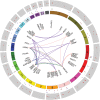A methylome-wide study of aging using massively parallel sequencing of the methyl-CpG-enriched genomic fraction from blood in over 700 subjects
- PMID: 24135035
- PMCID: PMC3919012
- DOI: 10.1093/hmg/ddt511
A methylome-wide study of aging using massively parallel sequencing of the methyl-CpG-enriched genomic fraction from blood in over 700 subjects
Abstract
The central importance of epigenetics to the aging process is increasingly being recognized. Here we perform a methylome-wide association study (MWAS) of aging in whole blood DNA from 718 individuals, aged 25-92 years (mean = 55). We sequenced the methyl-CpG-enriched genomic DNA fraction, averaging 67.3 million reads per subject, to obtain methylation measurements for the ∼27 million autosomal CpGs in the human genome. Following extensive quality control, we adaptively combined methylation measures for neighboring, highly-correlated CpGs into 4 344 016 CpG blocks with which we performed association testing. Eleven age-associated differentially methylated regions (DMRs) passed Bonferroni correction (P-value < 1.15 × 10(-8)). Top findings replicated in an independent sample set of 558 subjects using pyrosequencing of bisulfite-converted DNA (min P-value < 10(-30)). To examine biological themes, we selected 70 DMRs with false discovery rate of <0.1. Of these, 42 showed hypomethylation and 28 showed hypermethylation with age. Hypermethylated DMRs were more likely to overlap with CpG islands and shores. Hypomethylated DMRs were more likely to be in regions associated with polycomb/regulatory proteins (e.g. EZH2) or histone modifications H3K27ac, H3K4m1, H3K4m2, H3K4m3 and H3K9ac. Among genes implicated by the top DMRs were protocadherins, homeobox genes, MAPKs and ryanodine receptors. Several of our DMRs are at genes with potential relevance for age-related disease. This study successfully demonstrates the application of next-generation sequencing to MWAS, by interrogating a large proportion of the methylome and returning potentially novel age DMRs, in addition to replicating several loci implicated in previous studies using microarrays.
Figures




Similar articles
-
Epigenome-wide scans identify differentially methylated regions for age and age-related phenotypes in a healthy ageing population.PLoS Genet. 2012;8(4):e1002629. doi: 10.1371/journal.pgen.1002629. Epub 2012 Apr 19. PLoS Genet. 2012. PMID: 22532803 Free PMC article.
-
Rheumatoid arthritis-relevant DNA methylation changes identified in ACPA-positive asymptomatic individuals using methylome capture sequencing.Clin Epigenetics. 2019 Jul 31;11(1):110. doi: 10.1186/s13148-019-0699-9. Clin Epigenetics. 2019. PMID: 31366403 Free PMC article.
-
High-resolution analyses of human sperm dynamic methylome reveal thousands of novel age-related epigenetic alterations.Clin Epigenetics. 2020 Dec 14;12(1):192. doi: 10.1186/s13148-020-00988-1. Clin Epigenetics. 2020. PMID: 33317634 Free PMC article.
-
Mining cancer methylomes: prospects and challenges.Trends Genet. 2014 Feb;30(2):75-84. doi: 10.1016/j.tig.2013.11.004. Epub 2013 Dec 21. Trends Genet. 2014. PMID: 24368016 Review.
-
Base resolution methylome profiling: considerations in platform selection, data preprocessing and analysis.Epigenomics. 2015 Aug;7(5):813-28. doi: 10.2217/epi.15.21. Epub 2015 Sep 14. Epigenomics. 2015. PMID: 26366945 Free PMC article. Review.
Cited by
-
Epigenetics and aging.Sci Adv. 2016 Jul 29;2(7):e1600584. doi: 10.1126/sciadv.1600584. eCollection 2016 Jul. Sci Adv. 2016. PMID: 27482540 Free PMC article. Review.
-
DNA methylation aging clocks: challenges and recommendations.Genome Biol. 2019 Nov 25;20(1):249. doi: 10.1186/s13059-019-1824-y. Genome Biol. 2019. PMID: 31767039 Free PMC article. Review.
-
Epigenetics in drug disposition & drug therapy: symposium report of the 24th North American meeting of the International Society for the Study of Xenobiotics (ISSX).Drug Metab Rev. 2022 Aug;54(3):318-330. doi: 10.1080/03602532.2022.2101662. Epub 2022 Aug 24. Drug Metab Rev. 2022. PMID: 35876105 Free PMC article. Review.
-
Overview of Polyamines as Nutrients for Human Healthy Long Life and Effect of Increased Polyamine Intake on DNA Methylation.Cells. 2022 Jan 4;11(1):164. doi: 10.3390/cells11010164. Cells. 2022. PMID: 35011727 Free PMC article. Review.
-
Ischemic stroke patients are biologically older than their chronological age.Aging (Albany NY). 2016 Aug 25;8(11):2655-2666. doi: 10.18632/aging.101028. Aging (Albany NY). 2016. PMID: 27922817 Free PMC article.
References
Publication types
MeSH terms
Substances
Grants and funding
LinkOut - more resources
Full Text Sources
Other Literature Sources
Medical
Research Materials

